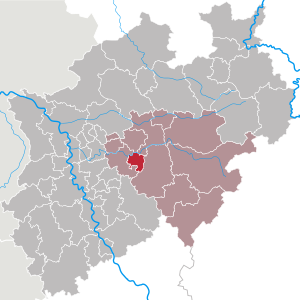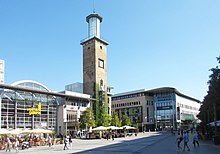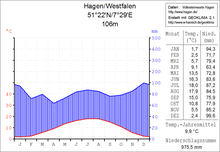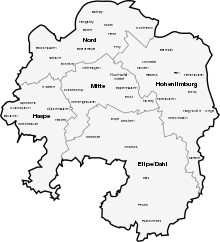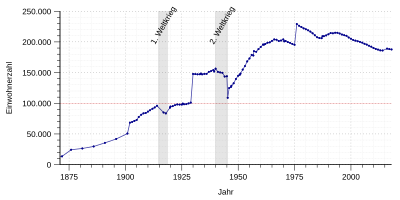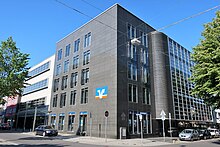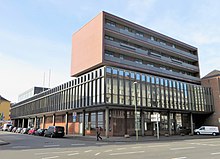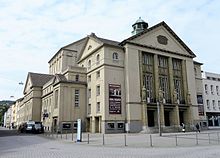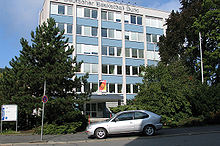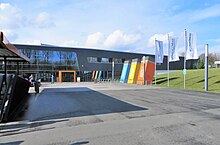Hagen
| coat of arms | Germany map | |
|---|---|---|

|
Coordinates: 51 ° 22 ′ N , 7 ° 29 ′ E |
|
| Basic data | ||
| State : | North Rhine-Westphalia | |
| Administrative region : | Arnsberg | |
| Height : | 106 m above sea level NHN | |
| Area : | 160.45 km 2 | |
| Residents: | 188,686 (Dec. 31, 2019) | |
| Population density : | 1176 inhabitants per km 2 | |
| Postcodes : | 58089-58099, 58119, 58135 | |
| Primaries : | 02331, 02334, 02337, 02304 | |
| License plate : | HA | |
| Community key : | 05 9 14 000 | |
| LOCODE : | DE HAG | |
| NUTS : | DEA53 | |
| City structure: | 5 boroughs | |
City administration address : |
Rathausstrasse 11 58095 Hagen |
|
| Website : | ||
| Lord Mayor : | Erik O. Schulz (independent) | |
| Location of Hagen in North Rhine-Westphalia | ||
Hagen is an independent city in the state of North Rhine-Westphalia . It is located on the south-eastern edge of the Ruhr area and is the largest city in South Westphalia . Hagen is often referred to as "the gateway to the Sauerland ".
The city of Hagen is a member of the Regional Association of Westphalia-Lippe and the Ruhr Regional Association and is located in the Rhine-Ruhr . Hagen is the seat of a local , regional and labor court as well as several nationally important institutes and administrative authorities.
Hagen is also the seat of the only state distance university in Germany. Since 2012, Hagen has officially added the name “City of FernUniversität”; the addition is noted in this spelling on the place-name sign .
Geography and geology

General geography
The largest expansion of the Hagen city area is 17.1 km in north-south direction and 15.5 km in west-east direction. The city limit of 89.7 km in length is made up of 3.3 km to Dortmund , 9 km to the Unna district , 56.6 km to the Ennepe-Ruhr district and 20.8 km to the Märkisches Kreis . The area of the city (160.36 km²) is roughly as large as that of the Principality of Liechtenstein .
42 percent of the Hagen city area consists of forest . The four rivers in Hagen extend over a length of 52.2 km: Ruhr 11.5 km, Lenne 13.1 km, Volme 21.3 km and Ennepe 6.3 km.
The difference in altitude from the lowest point on the Ruhr at Vorhalle ( 86 m above sea level ) to the highest point east of Bölling ( 438 m above sea level ) 7 ° 33'48 "E, 51 ° 17'30" N is 352 m.
The greatest gradients (with at least 20%) within the Hagen city area:
- Stairs street in Altenhagen with 28%
- Böhmerstraße in the city center with 27%
- Ewaldstraße in Wehringhausen with 27%
- Rehstrasse in Wehringhausen with 26%
- Tunnel road in Wehringhausen with 26%
- Kleiststrasse in Eppenhausen with 23%
- Boeler Strasse in Altenhagen with 21%
- Elfriedenhöhe in the city center with 20%
Geology and paleontology
The Hagen area has been a classic find region of paleontology and archeology since the early 19th century (see also: History of the City of Hagen ) .

In the urban area there are various rocks and deposits from the Devonian to the Carboniferous . In karst caves and crevices of the mass limestone, sea and land deposits from the Cretaceous and Tertiary and Holocene periods have been preserved.
Even today, the Hagen area is one of the world's most important sites for fossils from the middle and upper Devonian and lower Carboniferous. Numerous well-known sites that were still accessible in the 1980s were built over or filled in.
But other fossil sites with animal and plant remains from the Paleozoic to the Mesozoic made important contributions to geoscientific research. In the area of Hagen z. B. the bones of land dinosaurs and early mammals as well as plant remains from the Lower Cretaceous.
In Hagen-Ambrock in the Volmetal, remnants of land plants and armored fish from central Devon were discovered. The broad mass limestone range with dolomite - remnants of a Devonian coral reef - between Schwelm and Balve has been quarried since the early 19th century.
The former brickworks pit Hagen-Vorhalle is considered to be the world's most important site of discovery of 319 million year old insects and other fossils, including early dragonflies with wingspans of 40 cm, extinct primordial winged winged birds and giant centipedes and millipedes from the empty upper carbon. The Hagen-Vorhalle quarry is considered to be a geotope with global recognition for paleontological research. Finds from the quarry and from the entire region can be seen in the Museum of Prehistory and Early History in the Werdringen moated castle .
Deposits from early Tertiary river terraces of the Lenne and Ruhr have been preserved on the plateaus of Emst , Dahl and Hohenlimburg . Shark teeth, land snails and bones of mammals and marine animals as well as plant remains from the Tertiary were found in the fissures of the mass limestone near Emst and Hohenlimburg.
In a side valley of the Lenne near Holthausen , the remains of stone age people were discovered in the “ leaf cave ”. With a C14 age of up to 11,300 years ago, they date from the beginning of the Mesolithic . This makes them the oldest evidence of anatomically modern humans in the post-ice age on the European continent.
climate
| Climate data (1956 / 7-2010) | Jan | Feb | March | Apr | May | Jun | Jul | Aug | Sep | Oct | Nov | Dec | Annual mean / annual total |
|---|---|---|---|---|---|---|---|---|---|---|---|---|---|
| Temperature (° C) | 1.7 | 2.5 | 5.7 | 9.3 | 13.5 | 16.3 | 18.0 | 17.9 | 15.0 | 10.7 | 5.6 | 2.5 | 9.9 |
| Precipitation (mm) | 94.6 | 72.3 | 81.5 | 62.1 | 72.7 | 81.8 | 88.5 | 88.5 | 75.2 | 77.8 | 87.5 | 99.4 | 981.9 |
City structure
In the densely populated valleys of Volme and Ennepe as well as in the north of Hagen, the grown townscape corresponds to the typical building design of cities in the Ruhr area. Topographically, Hagen is comparable to the southern districts of Bochum, Essen and Mülheim. In the southern urban areas annexed after the regional reform in 1975, which are only sparsely populated, the landscape appears more Sauerland - with mountains, lakes and forests.
Hagen is divided into five city districts with a total of 186,465 inhabitants (2013) .
| Borough | District | Residents 2013 |
Area in km² |
Density in E / km² |
for comparison: | Population 2000 |
|---|---|---|---|---|---|---|
| center | 75,047 | 20.5 | 3,661 | Decrease 11.2% | 84,495 | |
| Mittelstadt | 20,468 | 2.7 | 7,581 | 22,311 | ||
| Altenhagen | 17.199 | 4.4 | 3,909 | 19.906 | ||
| College district | 12,409 | 3.5 | 3,545 | 13,081 | ||
| Emst | 10,677 | 4.3 | 2,483 | 11,455 | ||
| Wehringhausen | 14,294 | 5.6 | 2,552 | 17,742 | ||
| North | 36,909 | 29.6 | 1,247 | Decrease 7.8% | 40,048 | |
| lobby | 10,017 | 12.5 | 801 | 11,233 | ||
| Boele | 26,892 | 17.1 | 1,573 | 28,815 | ||
| Hasp | 29,245 | 22.2 | 1.317 | Decrease 6.5% | 31,268 | |
| Hasp -East | 16,811 | 14.7 | 1,144 | 18,069 | ||
| Hasp-West | 12,434 | 7.5 | 1,658 | 13.199 | ||
| Eilpe / Dahl | 16,019 | 51.1 | 313 | Decrease 14.1% | 18,643 | |
| Eilpe | 10,987 | 18.5 | 594 | 13.001 | ||
| Dahl | 5,032 | 32.6 | 154 | 5,642 | ||
| Hohenlimburg | 29,245 | 37.0 | 790 | Decline 11.4% | 33,017 | |
| Hohenlimburg | 24,616 | 22.7 | 1,084 | 28,046 | ||
| Lennetal | 4,629 | 14.3 | 324 | 4,971 |
history



middle Ages
The Hagen area appears for the first time in the Lorsch Annalen (Annales Laureshamenses) : In 775, the Saxon Hohensyburg (Sigiburg) , located near the city limits of Dortmund above the Ruhr-Lenne estuary, was conquered by the troops of Emperor Charlemagne .
The village and parish of Hagen were relatively insignificant in the Middle Ages and were politically, economically and socially behind the founding of the Brandenburg towns in the surrounding area, especially behind Iserlohn and the neighboring county of Limburg . Instead of “Dorf Hagen” or “Parish Hagen”, “Freiheit Hagen” (Minor town), belonging to the county of Arnsberg, was also used.
Early modern age
With the founding of the Lange Riege , Hagen acquired growing economic importance from the 17th century. The Lange Riege was built in Eilpe in 1661 and was a blade forge settlement with several water-powered hammer mills and forges. The settlement extends along the Selbeck brook near its confluence with the Volme.
A major fire destroyed a significant part of the buildings in Hagen in 1724. With the help of the Prussian state administration, Hagen could be rebuilt within a short time.
On September 3, 1746, a change in tax law was decreed, which historians regard as the granting of city rights to Hagen. Research has not yet found an exact date from when Hagen can officially be designated as a city .
Since 1817, Hagen has been the seat of an office and a district within the administrative district of Arnsberg. In 1837 the revised town order and a magistrate were introduced. In the course of industrialization, Hagen was connected to the network of the Bergisch-Märkische Eisenbahngesellschaft in 1848 and developed into an important railway junction.
By 1865, Hagen had overtaken the town of Iserlohn, which had previously been the leader in South Westphalia in terms of population and economic power. Together with Iserlohn, Hagen has been the cultural, administrative and economic center of the southern county of Mark since the middle of the 19th century .
German Empire
During the German Empire from 1871 to 1914 Hagen experienced a heyday. Due to urbanization and industrialization , the city developed into the regional center for the entire region south of the Ruhr. In 1887, Hagen left the district of Hagen under administrative law and became an independent city .
In the years after the turn of the century, the banker and patron Karl Ernst Osthaus brought many important architects such as Henry van de Velde , Peter Behrens and Walter Gropius to the city. They established Hagen's reputation as a link between Art Nouveau and modernity (" Hagen Impulse "). The focus of this initiative was the Folkwang Museum and the (rudimentary) garden city of Hohenhagen .
Benefiting from Hagen's position as a railway traffic junction, Peter Klöckner built a large blast furnace and steel works, the Hasper Hütte , in the neighboring town of Haspe, which was still independent at the time . A local branch of the NSDAP had existed in Hagen since spring 1922 . The city's population exceeded 100,000 in 1928, making Hagen a major city. Through further incorporations this rose to around 150,000 inhabitants by 1939. During the November pogrom in 1938 , the synagogue built in 1859 on Potthofstrasse was destroyed.
During the time of National Socialism , people with a Jewish background were also harassed in Hagen and murdered in concentration camps . During the Second World War was the Hagen city center by several air raids almost completely destroyed, leaving only the neighboring districts the late nineteenth reflect architectural character of the city. The buildings of the “Hagen Impulse”, which are interesting from an architectural point of view, were largely preserved due to their location far from the city center. The US Army finally occupied Hagen between April 14 and 17, 1945. Elsewhere in Germany, the war continued until the beginning of May. The war finally ended on May 8th with the unconditional surrender of the Wehrmacht . More than 2,200 people were killed in the bombing raids. Over 10,000 citizens of Hagen died in the war on the front lines.
post war period
After the Second World War, Hagen was in the British Zone . In the 1950s and 1960s, Hagen experienced further rapid growth and expanded mainly into the flatter, northern plain. Today's city center is thus south of the main residential area.
Belief in progress and increasing motorization made - apart from the retained historical street layout - the remnants of the historic inner-city development disappear. The plans for a car-friendly city , which should lead car traffic through the city by means of elevated roads, were only partially realized. A witness of these years is today an elevated street at the Altenhagener Brücke, which leads past the upper floors of a historic row of old buildings.
Another elevated road is the 1740 meter long Volmetal Bridge in Eilpe . The road expansion not only had to give way to numerous buildings in Hagen, but in 1976 the tram service was also discontinued.
Late 20th century until today
On January 1, 1970, Hagen was expanded to include Waldbauer . However, this incorporation was canceled after a court judgment on December 18, 1970. Waldbauer became independent again and incorporated into the city of Breckerfeld on January 1, 1975 through the Sauerland / Paderborn law .
In the early 1970s, heavy industry began to decline in Hagen as a result of the steel crisis . The Hasper Hütte was completely shut down between 1972 and 1982, the Gussstahlwerke Wittmann went bankrupt and two of three factories of the Stahlwerke Südwestfalen were closed. Further job losses affected the food industry with the Bettermann and Andreas breweries, the confectionery manufacturers Villosa and Grothe and the production company of Zwieback Brandt .
The eastern part of the urban area of Hagen has been extending to the territory of the former county of Limburg with the previously independent city of Hohenlimburg since January 1st, 1975 . From the late 1970s onwards, the job losses were partly offset by the industrialization of the Lennetal. The latter was one of the decisive factors in the efforts to incorporate Hohenlimburg, whose cold rolling industry was economically stable and generated an increase in jobs.

At the beginning of the 1980s, Hagen made a name for itself as the “Liverpool of the Neue Deutsche Welle ”. Many well-known musicians and bands of this genre (including Nena , Extrabreit and the sisters Annette and Inga Humpe ) have their roots in Hagen.
In the 1980s, Hagen was able to hold its own economically well against its northern neighbors Dortmund, Witten and Bochum. To date, the average unemployment rate is around 3 percentage points below the average for the cities in the Ruhr area. The unemployment rate in Hagen was 8.1% in November 2012.
Economically, Hagen came under renewed pressure in the 1990s due to increasing globalization. Another wave of de-industrialization began in the steel sector, which can be seen from the almost complete disappearance of factories in Hohenlimburg's Nahmertal. At the same time, there was another decline in population in Hagen. On December 31, 2012, the debt level in Hagen was € 1,383 million.
Significant new construction and renovation projects have been carried out since the 2000s, which today have a major impact on Hagen's cityscape. Examples are: the Volme- and the Rathaus-Galerie , the redesign of the Friedrich-Ebert-Platz and the station forecourt (Berliner Platz) as well as the construction of the town hall on the Volme.
The so-called train station experience is currently one of the most important urban development projects in North Rhine-Westphalia.
In 2017, Hagen was included in the 27th edition of the Duden .
Population development
Hagen became a major city in 1928 when the population topped 100,000. In 1964 the limit of 200,000 inhabitants was exceeded. The city had the highest population after the reorganization in 1975 with 231,840 inhabitants.
Since December 2005, the city (according to information from the city administration) has permanently fallen below the number of 200,000 inhabitants, while the State Office for Data Processing and Statistics North Rhine-Westphalia assumed only 196,934 inhabitants at this time.
In the size ranking of the major cities in Germany, Hagen is in 41st place behind Kassel and ahead of Hamm . According to the "2011 Census", the number of inhabitants in Hagens fell to 187,333 in 2011.
The proportion of the population aged under 20 in Hagen was 19.4% in 2018, and the proportion of the population aged 60 or more was 28.3%. The proportion of foreigners in Hagen was 19.1% in 2018.
politics
Mayor and Lord Mayor
- 1733–1746: Peter Matthias Wülfingh
- 1746–1749: Heinrich Wilhelm Emminghaus
- 1749–1750: Heinrich Caspar Hiltrop
- 1750–1771: Johann Caspar Hücking
- 1771–1795: Heinrich Arnold Wülfingh
- 1795–1809: Peter Matthias Jule
- 1809–1821: Carl Ludwig Christian Dahlenkamp
- 1821–1823: Wilhelm Möllenhoff
- 1823–1827: Fr. Pütter
- 1827–1831: JH Wille
- 1831–1832: Friedrich Wilhelm Kämper
- 1832–1835: Johann Peter Aubel
- 1835–1837: Friedrich Wilhelm Kämper
- 1837–1849: Ferdinand Elbers
- 1849–1864: Johann Diedrich Friedrich Schmidt
- 1864–1876: Friedrich Dödter
- 1876–1900: August Prentzel
- 1901–1927: Willi Cuno , ( FVP , from 1918: DDP )
- 1927–1929: Alfred Finke (DDP)
- 1929–1933: Cuno Raabe ( center )
- 1933–1945: Heinrich Vetter ( NSDAP )
- 1945 : Werner Dönneweg (NSDAP, provisional from April 18 to May 18, 1945)
- 1945–1946: Ewald Sasse (CDU, from May 18, 1945 initially provisional, later full-time)
- 1946–1956: Fritz Steinhoff ( SPD )
- 1956–1963: Helmut Turck (SPD)
- 1963–1964: Fritz Steinhoff (SPD)
- 1964–1971: Lothar Wrede (SPD)
- 1971–1989: Rudolf Loskand (SPD)
- 1989 : Renate Löchter (SPD)
- 1989–1999: Dietmar Thieser (SPD)
- 1999-2004: Wilfried Horn (CDU)
- 2004–2009: Peter Demnitz (SPD)
- 2009–2014: Jörg Dehm (CDU)
- 2014– : Erik O. Schulz (independent)
Since 1996, the mayor has been the full-time head of administration again.
City council
| SPD | CDU | Green | Hagen active | left | AfD | FDP | BfHo / pirates |
Non- attached |
total |
|---|---|---|---|---|---|---|---|---|---|
| 18th | 20th | 5 | 4th | 3 | 3 | 3 | 3 | 3 | 62 |
| AfD 2, non-party 1 |
FDP 2, non-party 1 |
BfHo 2, PIRATES 1 |
per NRW 1 |
A council member resigned from HAGEN AKTIV immediately after the election and, as a non-party, made it possible for an AfD parliamentary group to be formed. Another council member resigned from the SPD immediately after the election and, as a non-party member, enabled an FDP parliamentary group to be formed. The two council members of the BfHo and the PIRATEN have merged to form the BfHo / Piraten council group, a previous member of the SPD joined the BfHo in 2017 so that the strength of the faction was achieved.
In the city council, the CDU, the Greens and the FDP have formed a coalition that supports the mayor. Even with the mayor's vote, the coalition only got 30 out of 63 votes and is dependent on the support of at least two other council members.
City coat of arms and city name
Blazon of the coat of arms of Hagen: "In a stylized blue golden fünfästige, elfblättrige oak."
Declaration of the coat of arms: The eleven leaves stand for the eleven districts of Hagens (Mitte, Altenhagen, Boele, Emst, Dahl, Wehringhausen, Vorhalle, Eilpe, Haspe, Hohenlimburg and the university district) and the five branches symbolize the five rivers that run through Hagen (Ruhr , Lenne, Volme, Ennepe and the Hasperbach). This interpretation is doubted, however, because at the time the coat of arms was created, the present-day districts of Haspe, Hohenlimburg, Dahl and Boele did not yet belong to the city of Hagen. In addition, the university district only exists in the vernacular to this day; at the time of the creation of the coat of arms there was no university in Hagen. There used to be a coat of arms with a Westphalian oak with three towers on a wall crown. When Hagen joined the number of large cities, the top of the wall received five towers.
The origin of the name "Hagen" is not exactly known. In the late Middle Ages, the field name Hagen referred to a low earth wall with stakes, often connected by wickerwork, to protect a homestead from intruders and to prevent the cattle from running away. Sometimes the stakes were replaced by living bushes, the hawthorn with the hare rose and rose hips. Here in his hagen the farmer sat safe and secure, he was comfortable. He cherished his possessions. Anyone who came into his compound could easily become uncomfortable.
However, this interpretation of the origin of the name is not scientifically proven and is viewed critically by some historians. Other scientists argue that the name "Hagen" is derived from Hafen (see also Copenhagen, in the local language København). The location of the city on four rivers is seen as an indication of this.
Town twinning
Hagen is twinned with the following cities:
|
Infrastructure and economy
In 2016, Hagen achieved a gross domestic product (GDP) of 6.235 billion euros within the city limits . In the same year, GDP per capita was € 33,048 (North Rhine-Westphalia: € 37,416, Germany € 38,180) and thus slightly below the regional and national average. In 2016 there were around 98,000 employed people in the city. The unemployment rate in December 2018 was 9.1% and thus well above the average for North Rhine-Westphalia of 6.4%.
economy
The South Westphalian Chamber of Commerce and Industry , founded in Hagen in 1843, is responsible not only for the south-eastern Ruhr area (city of Hagen, Ennepe-Ruhr district ) but also for the Märkische Kreis .
Heavy industry dominated the city until the 1970s, but Hagen is no longer at home. The regionally important brewery Andreas ceased operations in July 1995.
Economically, the city is today characterized by medium-sized metalworking industry and increasingly by the service industry. Well-known companies such as Varta (since 2000: Hawker-Batteries / EnerSys), Europart Holding , Westfalia , Christ , Hussel , Thalia Bücher , Kabel Premium Pulp & Paper , Friedr. Gustav Theis Kaltwalzwerke , CD Wälzholz , Westfa , SinnLeffers and Brandt (since 2002 production in Ohrdruf, Thuringia ) have their headquarters in the city.
The HagenAgentur takes care of business issues in the city; it emerged in 2009 from the WFG business development agency.
From September 2013, Ewald Dörken AG made one of the largest investments in the history of the city with the establishment of a spunbond production facility in the Vorhalle district for a total of 35 million euros (as of September 2013).
In order to expand the retail trade, the Volme Gallery was opened in 2003 with over 60 shops. The Rathaus-Galerie was opened in 2014 with around 80 retail stores. Both shopping galleries are centrally located on Friedrich-Ebert-Platz.
Two major credit institutions have their headquarters in Hagen: Sparkasse Hagen- Herdecke and Märkische Bank (Volksbank).
With numerous associations, clubs, many cultural and leisure activities and diverse shopping opportunities, Hagen is classified as a regional center . So Hagen competes with surrounding larger cities such as Dortmund , Bochum and Wuppertal .
traffic
Hagen is connected to the ICE network . Long- distance trains, both nationally and internationally, run regularly from Hagen Central Station . Hagen is also the interface of important motorway connections in north-south and east-west directions.
Rail and bus transport
Since 1848, Hagen has been an important rail hub in Germany. The main station is an important long-distance , regional and S-Bahn station in the southeastern Ruhr area. In terms of freight traffic, the Hagen-Vorhalle station is one of the largest marshalling yards in Germany.
In addition to the main train station, Hagen has several train stations in different parts of the city. The stations in Hagen that are currently in / (out of) operation are: Hagen Hauptbahnhof (all trains), Hagen-Vorhalle , Hagen- Wehringhausen , Hagen- Heubing and Hagen-Westerbauer (S 5 and S 8), Hagen-Oberhagen, (-Delstern), (-Ambrock), Dahl and Rummenohl ( Volmetalbahn ); as well as (-Kabel), (-Halden), Hohenlimburg ( Ruhr-Sieg-Express or -Bahn ).
In Schienenpersonenfern- and mass transit run a series of long-distance , regional express train - and train -lines. The ICE connections to Berlin and Basel , the RegionalExpress lines to Kassel , Aachen , Siegen / Iserlohn and Venlo deserve special mention . Local rail passenger transport (SPNV) is operated by DB Regio NRW , Abellio Rail NRW and Eurobahn . See also: S-Bahn Rhein-Ruhr
But also the museum railway RuhrtalBahn , which has been in regular service since 2005, between Hagen and the Bochum-Dahlhausen Railway Museum should be mentioned. The Ennepetalbahn is also used for the same purpose .
In terms of local road transport , Hagen has an extensive network of 36 bus routes , including an express bus route . In addition, there are 16 night express lines on weekends and before public holidays . There are not only then u. a. Connections to Dortmund , Witten , Gevelsberg and Schwerte .
The tram operated in Hagen from 1884 to 1976 . In 1973, the concept of the cabin taxi was tested in Hagen-Vorhalle .
The Haspe district of Hagen was the starting point for the Haspe – Voerde – Breckerfeld small train , which was counted as one of the most beautiful tram routes in Germany by the local public transport company Hagener Straßenbahn AG while it was in operation as an interurban tram.
There were plans to run the Volmetalbahn from Dortmund via Hagen to Lüdenscheid as a light rail . It should run directly from Dortmund city center via Hagen city center to downtown Lüdenscheid . In 1997, a concept for the Hagen regional light rail system was presented, which was not implemented for cost reasons despite the transport benefits.
The tariff of the Verkehrsverbund Rhein-Ruhr (VRR) applies to all local public transport and the NRW tariff applies to all tariff areas . There is a transitional arrangement for the Westphalian tariff.
Road network
Motorways with a total length of 32.7 km run in the city of Hagen . A 1 / E 37 (Hansalinie) 10.7 km, A 45 / E 41 (Sauerland line) 14.8 km, A 46 7.2 km. Hagen has the following motorway junctions: Hagen North, Hagen West (A 1); Hagen South (A 45); Hagen-Hohenlimburg, Hagen-Elsey (A 46).
The federal highways B7 , B54 and B226 run through the city of Hagen with a total distance of 41.0 km.
Cycle path network
The cycle network in Hagen is part of the NRW cycle path network and is signposted after it. In addition to the RuhrtalRadweg and the Lenneroute , other long-distance cycle routes also run through the city. In addition, there are only a small number of other local cycle paths; a long-term cycle path concept is being planned.
Air traffic
Hagen's airfield ( special landing site ) with the ICAO ED6015 and the geographical location 51 ° 18 ′ 24 ″ N , 7 ° 25 ′ 29 ″ E near Hof Wahl (consisting of a green meadow) is about 1.5 km northeast of the Hasper dam , embedded in an idyllic forest landscape. Landing permits for non-club members are not granted there. Plans for a commercial airport in Hagen-Emst were given up by the city administration as early as the 1930s.
Public facilities
Hagen is the seat of many important public institutions. Examples include:
- Since 1844 the city has been the seat of the South Westphalian Chamber of Commerce and Industry (SIHK). The chamber district, one of the oldest in today's state of North Rhine-Westphalia , includes the independent city of Hagen as well as the Ennepe-Ruhr district (excluding Witten and Hattingen) and the Märkischen district .
- With the agency mark GmbH , the city of Hagen, together with the Märkischer Kreis and the Ennepe-Ruhr-Kreis, operates a regional company that takes care of employment development and the promotion of education and training.
- The Landesbetrieb Straßenbau NRW has a branch in Hagen with five road maintenance services for the maintenance of the road network in the independent cities of Hagen, Hamm and the Unna, Ennepe-Ruhr-Kreis and Märkischer Kreis districts.
- Hagen is the seat of the Hagen District Court and the Hagen District Court , which is responsible for a total of nine district courts. In addition, the district court acts as Hagen central dunning court for the Court of Appeal districts Hamm and Dusseldorf. In addition, there is a labor court in Hagen .
- The Hagen correctional facility is currently the only induction facility in North Rhine-Westphalia. There, all male adult prisoners with a term of imprisonment of over 24 months are tested in the referral procedure and moved to the relevant penal institution. The JVA Hagen has 323 places of detention, 100 of which are for prisoners on remand. The JVA Hagen was completed as a city prison in 1923 in an atrium construction, expanded in the 1950s by a work hall and in 1977 (after the penal law came into force ) as a detention center.
- The Deutsche Bundesbank operates one of its most important branches in the city center of Hagen. It is primarily responsible for the supply of cash in North Rhine-Westphalia.
- A new main fire station was set up near Autobahn 46 in Hagen-Hohenlimburg. It is one of the largest fire stations in Germany with around 30 emergency vehicles. The old Hauptwache in the city center (near the General Hospital) is still in operation.
- There are six hospitals and three specialist clinics in Hagen. Three of the hospitals are centrally located in the city center, the other three in the districts of Haspe , Boele and Hohenlimburg . The three specialist clinics can be found in the districts of Eilpe / Dahl (Ambrock) and Haspe (Deerth) and Nord (Vorhalle). The “Heilig Geist” hospital in Haspe was closed a few years ago; the only oral and maxillofacial surgery (MKG) located in Hagen was relocated to the St. Josef Hospital.
- The city of Hagen is responsible for providing addiction support that includes low-threshold contact offers, advice, substitution and abstinence orientation.
Education and Research
The city is home to the Open University in Hagen , with around 76,936 students (as of WS 2019/20) the largest university in Germany. The faculties of the distance university are: cultural and social sciences, mathematics and computer science (with an area for electrical engineering and information technology), law and economics.
Hagen is also the location of two universities of applied sciences: the South Westphalia University of Applied Sciences (headquarters: Iserlohn ) and the North Rhine-Westphalia University of Applied Sciences for Public Administration , where the Gelsenkirchen department is studying .
All types of schools are available in Hagen. The city also has a wide range of training opportunities, including a. the municipal adult education center in Hagen and the Rahel-Varnhagen-Kolleg . In addition, Haus Busch is a nationwide important training and further education center for journalists.
The Hagen Historical Center conducts research in the fields of history and archeology . It is integrated into international research networks and operates two nationally known museums for urban and regional history as well as for archeology and paleontology.

The Volkssternwarte Hagen at the Eugen-Richter-Turm is a voluntary institution that was founded in 1955. Regular opening times give citizens the opportunity to find out more about astronomy and meteorology .
The Hagen planetary model represents our solar system in the form of bronze plates that are true to scale in the Hagen city area, primarily in the city center. The sphere of the town hall tower represents the sun as the model center. This gives the viewer an idea of the structure and size of our planetary system. The idea for the model was published in 1959; it was mostly realized between 1960 and 1975, and it can be seen as a memorial to the space era of that time.
media
Two daily newspapers report on regional events in Hagen: Westfalenpost and Westfälische Rundschau . Both newspapers belong to the Funke media group . The two newspapers have been appearing in a joint local edition since 2013, for which the Westfalenpost editorial team is responsible.
The free advertising paper Stadtanzeiger appears twice a week , and the cultural magazines HaKen and Courage appear once a month .
With 107.7 Radio Hagen , the city has its own local radio station.
Religions
Denomination statistics
According to the 2011 census , 34.2% of the residents were Protestant , 29.1% Roman Catholic and 36.7% were non-denominational , belonged to another religious community or did not provide any information. Currently (as of December 31, 2018), 28.7% of the residents are Protestant, 26.6% Roman Catholic and 44.7% are non-denominational or belong to another religious community. A year earlier on December 31, 2017, 29.3% of the population were Protestant, 26.9% Roman Catholic and 43.8% belonged to other denominations or religious communities or were non-denominational.
Old Catholic parish
- Old Catholic Church of the Resurrection
Evangelical Free Churches
- Evangelical Free Church Hagen
- Evangelical Free Church Congregation Hohenlimburg
- Evangelical Free Congregation Anskar Church Hagen
- Free Protestant Congregation Hagen
- Free Evangelical Congregation Haspe
- Free Evangelical Community of Hohenlimburg
Evangelical parishes ( Evangelical Church of Westphalia )
- Evangelical Lutheran Church of Christ ( Eilpe )
- Evangelical Lutheran Parish Elsey ( Hohenlimburg )
- Evangelical Lutheran Trinity Parish ( Eppenhausen )
- Evangelical Lutheran Emmaus parish
- Evangelical Lutheran Peace Church Congregation (Halden)
- Evangelical Lutheran Parish Haspe
- Evangelical St. James Parish ( Help )
- Evangelical Lutheran St. Matthew Church Congregation
- Ev. Markus Church (Altenhagen)
- Ev. Melanchthon parish
- Ev. Paul Gerhardt parish (Boelerheide)
- Evangelical Lutheran Paulus Parish (Wehringhausen)
- Ev. Phillip Nicolai Church in Boele. The parish hall from 2008 was honored with the award of exemplary buildings in North Rhine-Westphalia .
- Evangelical Reformed Church Congregation
- Evangelical Lutheran parish
- Ev. Parish vestibule
- Ev. Reformed Church Hohenlimburg
- Ev. Resurrection parish (created in October 2012 through the merger of the former parishes of Dahl and Rummenohl)
Roman Catholic parishes
- St. Andreas (Help)
- St. Anthony of Padua (cable)
- St. Boniface (Hasp)
- St. Boniface (Hohenlimburg)
- St. Elisabeth (Hagen)
- St. John Baptist (Boele)
- St. Josef (Altenhagen)
- St. Marien (city center)
- St. Meinolf (Altenhagen)
- St. Michael (Wehringhausen) and Maria, Help of Christians (Kuhlerkamp)
- St. Konrad (Westerbauer)
- St. Petrus Canisius (Eckesey)
- Christ the King (Boelerheide)
- Holy Spirit Church (Emst)
- Holy Cross (Halden)
- Heart of Jesus (Eilpe / Delstern)
- Liebfrauen (vestibule)
- Herz Jesu (Dahl + Rummenohl)
Islamic communities
- DITIB -Sultan Ahmet Mosque Hagen-Haspe e. V.
- IGBD - Municipality of Hagen e. V. (Wehringhausen)
- Kurdish-Islamic Association V. (city center)
- DITIB -Zentral-Moscheeverein e. V.
- Islamic Community Milli Görüs e. V.
- Education and Culture Association Hagen e. V. (city center, opposite the employment office high-rise) ( VIKZ )
- Islamic Community Hagen e. V. (Altenhagen)
- Alevi community (Haspe)
Jewish community
The Jewish community of Hagen was founded in 1819. The dead of the Kehillah are buried in the Jewish cemetery in Eilpe . The Kehillah is a member of the regional association of the Jewish communities of Westphalia-Lippe .
Jehovah's Witness
Meetings of Jehovah's Witnesses can be found in Hagen-Mitte, Hagen-Nordost, Hagen-Nordwest, Hagen-Ost and Hagen-West (with a Romanian-speaking group).
Culture and leisure
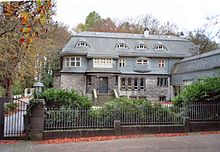

In terms of culture, Hagen is one of the most important centers in North Rhine-Westphalia . In addition to the well-known Osthaus Museum and the Hagen Historical Center , the LWL Open Air Museum Hagen and the Museum of Prehistory and Early History are located in the city.
In August 2009, the Emil Schumacher Museum, which is located in the immediate vicinity of the Osthaus Museum , was opened, which received much attention.
Public cultural institutions
As a regional center, Hagen has a number of nationally important cultural institutions, some of which also have an international impact:
- Kunstquartier with the Osthaus Museum and the Emil Schumacher Museum (opened: 2009); shows mainly modern and contemporary art and houses the European Showcase Museum for artistic shop window designs
- Theater Hagen (mainly opera , operetta , dance and music theater, guest performances and own production of drama) and Philharmonic Orchestra Hagen (symphony concerts, family concerts, concert introductions)
- Hohenhof - Museum of the Hagen Impulse in Hagen-Emst
- Westphalian Open Air Museum - State Museum for Crafts and Technology ( Selbecke district , in the Mäckingerbachtal)
- Wasserschloss Werdringen - Museum of Prehistory and Early History in the Vorhalle district; Nationally important collection and exhibition on paleontology and archeology
- Historic Center Hagen in the Eilpe district; City museum, city archive, Westphalian music and literature archive
- Kultopia (formerly Buschey Youth Center, later Globe ); today a municipal youth and culture house with a workshop and children's program as well as concerts and intercultural projects.
Other cultural institutions
A number of other, predominantly privately funded, cultural institutions are significant in Hagen:
- Bunker Museum Hagen in the middle town
- AllerWeltHaus in the center (meeting point "Café Mundial", Weltladen, archive, library, publications and further education)
- Pelmke cultural center in Wehringhausen (district café, art house cinema , concerts, cabaret, workshops)
- Werkhof in Hohenlimburg (concerts, cabaret, inter-company training)
- Public observatory Hagen in the city forest at the Eugen-Richter-Turm
- Hasper Hammer (cabaret, concerts, theater groups and guest performances, festivals) in Haspe
Significant structures
All architectural monuments are listed in the list of architectural monuments in Hagen .
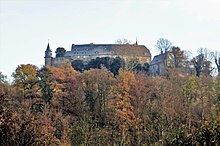
There are numerous historical monuments to visit in Hagen:
- Hohenlimburg Castle (Hohenlimburg, castle complex from the 13th century with a private castle museum for courtly living culture)
- Werdringen moated castle from the 13th century, vestibule district
- Lange Riege - half-timbered workers' settlement from 1665 (Eilpe, residential buildings for blade smiths)
- Harkorten House - Haspe district, former seat of the Harkort family of merchants and entrepreneurs, who were important between the 17th and 19th centuries, Friedrich Harkort's birthplace
- Hohenhof with Art Nouveau settlement (residence of Karl Ernst Osthaus and planned center of the "Garden City Emst", today a public museum)
- Four important towers from the 19th century: ( Freiherr-vom-Stein-Turm in the vestibule, Kaiser-Friedrich-Turm , Eugen-Richter-Turm and Bismarck-Turm on the Goldberg )
- Villa Post - historical villa in the late classical style in the district of Wehringhausen. Seat of the adult education center in Hagen .
- Johanniskirche with a polygonal choir and a nave hall from 1748 to 50 as well as a historicist west end from 1903. Some weathered grave slabs (probably 18th century) are placed on the exterior.
- Elbershallen (former Elbers textile factory ), a listed site consisting of historical administration buildings, detailed brick houses, interesting production halls and an 80 meter high chimney.
- Funkenhausen - a listed manor in the Vorhalle district.
- Haus Ruhreck - entrepreneur's villa in the style of a castle in the Eckesey district.
- numerous Art Nouveau buildings (especially in the garden city of Hohenhagen and in the Wehringhausen district).
See also: blown up Sparkasse skyscraper "Langer Oskar"
Protected areas for nature
Since December 1994 there has been a landscape plan of the city of Hagen for the city area , in which the areas outside the built-up districts and the scope of a development plan were designated as landscape protection areas, provided that there is no higher protection status such as a nature reserve (NSG).
There are a total of 24 nature reserves of various sizes in the urban area. The size goes from the nature reserve Bachtal acid Epscheid with 1.87 ha to the nature reserve mast mountain and white stone ha with 88.13. Since 2004, the nature reserve mast mountain and white stone, are nature reserve Temporary mast mountain , nature reserve Long trees , nature reserve Hunenpforte and nature reserve Raffenberg together as FFH - Lime beech forests area near Hohenlimburg designated. The nature reserve Aske also belongs together with the nature reserve Gevelsberger city forest to FFH area Gevelsberger city forest .
There are 43 protected landscape areas in Hagen. The area extends from the Rosengarten landscape protection area north of Eppenhauser Straße with 3.08 ha to the Tücking, Auf der Halle and surrounding area with 921.52 ha.
In 2010 there were 71 natural monuments (ND) in the city. 54 natural monuments are old individual trees or remarkable groups of trees, while the other 17 natural monuments are mostly karst caves, in which numerous fossils have been found, and tunnels. The two oldest trees in Hagen are the approx. 1000-year-old linden trees , which are designated as ND :
- the Rumscheider Femelinde (court linden tree) in the district of Dahl and
- the Priorlinde in the Priorei district .
In the urban area there are also 91 protected landscape components (LB) with an area of up to 5 hectares. In addition, all orchards with an area of 0.25 hectares or more within landscape protection areas and all head trees in the landscape plan area were designated as LB.
Parks
The city of Hagen is embedded in a wooded low mountain range.
In the inner-city area there is the Volkspark and the Dr. Ferdinand David Park in the city center as well as the city garden close to the city center above the General Hospital.
Funckepark is a smaller park in the upper Altenhagen area. It is named after the Hagen industrialist family Funcke, from which the FDP politicians Oscar and Liselotte Funcke also come.
Finally, there are the park-like facilities around the Ischelandteich, which border on the new Westfalenbad. In the Hohenlimburg district there is also the Lennepark (between the canoe slalom course and the indoor swimming pool).
Sports
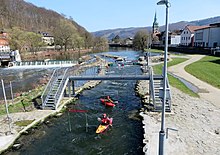
There are a large number of sports clubs in Hagen. These clubs are organized in the Stadtsportbund Hagen and in the Association for Sports in Hohenlimburg. In total, the interests of around 240 associations with around 46,000 members are represented here. The sports youth in the Stadtsportbund Hagen has hosted the Ruhr Olympiad three times so far .
- Basketball: Hagen is the seat of the German Basketball Federation (DBB). The SSV Hagen , who u. a. 1974 German basketball champion and 1975 German cup winner, as well as the club Brandt Hagen , which was temporarily represented in the first division but now dissolved , was a founding member of the basketball league and German cup winner in 1994. The currently most successful basketball club in the city is Phoenix Hagen ( 2nd basketball team Bundesliga ProA ). The TSV Hagen 1860 plays as " Phoenix Ladies " is currently in the second Ladies Basketball League . SV Hagen-Haspe 70 plays in the 2nd Regionalliga West.
- Sports bowling: The bowling center in Hagen has been a center of bowling in Germany and the rest of the world for decades. Hagen sports bowlers such as For example: Willi Wortmann, Manfred Pick, Katja Ricken & Benjamin Schulz on a national and international level. Clubs such as Germania Hagen, Jupiter Hagen and Blau Gold Hagen and others have achieved considerable success in league play. Since 2017, the bowling center has no longer been used by bowling and is used as an event location.
- Handball: With VfL Eintracht Hagen , the city is represented in handball in the 2nd Bundesliga . In previous decades, the club played in the 2nd Bundesliga for many years and only narrowly missed promotion to the handball Bundesliga a few times. From 2000, Eintracht Hagen played regional league and 3rd league for several years. The promotion to the second highest German division was achieved in 2015. The venue is the Krollmann Arena . The TuS Volmetal plays in the third league.
- Fistball: Most of Hagen's successes (also internationally significant) can be recorded in fistball : TSV Hagen 1860 won ten German championships, seven European Cup winners, three World Cup winners and in the hall seven German champions and twelve European Cup winners in a row.
- Water polo: In water polo , Hohenlimburger SV plays in the Women's Oberliga NRW and Women's District League NRW (multiple German water polo champions ).
- Tennis: TC Rot-Weiß Hagen played in the tennis Bundesliga in 1980, 1988 and from 1990 to 2001 .
- Table tennis: At the end of the 1980s, SSV Union Hagen was represented by the women's team in the 2nd table tennis Bundesliga.
- Triathlon: The Tri-Team-Hagen is active in the 1st women's triathlon national league. In their 2013 premiere season, they were able to establish themselves in the Bundesliga as 5th overall and third on the Schliersee.
- Motorsport: In motorsport, Hagen is home to two automobile clubs. With the Hagener Automobile Club 1905 e. V. in the ADAC (HAC), Hagen has one of the most traditional clubs in Germany, which today operates from kart racing (youth group) to automobile slalom and classic car activities. The Märkische Automobil-Club e. V. im AvD , as one of the largest local AvD clubs, can also look back on a long tradition (since 1925). In addition to events in kart, automobile and classic car racing, social and cultural events round off the active AvD club life.
- Canoeing: Hohenlimburg wild water park (canoe slalom route with performance center)
- Football: In the Landesliga Westfalen of play SV Hohenlimburg 1910 and the Hasper SV . Hagen has a total of 31 football pitches (four natural and five artificial turf pitches as well as 22 ash pitches). The largest soccer fields are:
- Ischelandstadion (natural grass, around 16,500 spectators)
- Kirchenberg Stadium (natural grass, approx.7,500 spectators)
- Boelerheide arena (natural grass, approx.4,500 spectators)
- Helfe stadium (artificial turf, approx.4,250 spectators)
- Haspe sports and leisure facility (artificial turf, approx. 4,000 spectators).
Other sports clubs in Hagen:
- Hasper Fecht-Club 1932/97 e. V. (nationally successful association in foil fencing )
- TV Hasperbach 1898 e. V. ( archery , West German champion)
- Sauerland Mustangs (TSV Fichte Hagen 1863 e.V.) ( American Football , Landesliga / Nord)
- BSC Hagen Chipmunks e. V. ( baseball , association league)
- Karate & Fitness Center e. V. (multiple German karate master)
- Box-Sport-Club Haspe 1949/97 eV (box club, children and youth training, women training & fitness boxing, men training)
- Blau Gold Hagen ( bowling , NRW League)
- Camel Fighters, Chupa Chups and Snakes: Participants in darts competitions
- Jugger Club Hagen e. V.
leisure

Hagen has a wide range of leisure facilities:
- Ischelandstadion (for major sports and music events, seating 16,500 spectators)
- Stadthalle Hagen (with an impressive glass facade) with various music, show, comedy and other events as well as various exhibitions.
- Westfalenbad (opened 2010); Hengstey, Hestert and Henkhausen outdoor swimming pools (jointly owned).
- Mountain bike routes: In 2008 two MTB routes were opened in the Hagen city forest.
- Shipping and water sports on the Hengsteysee
Events
There are a large number of regularly held events in Hagen:
- Eat My Shorts - Hagen Short Film Festival (annual short film festival)
- Europe weeks in May (festival, concerts, exhibitions, lectures, symposia with an integrative reference to Europe)
- City festival Hagen is flourishing (one weekend a year there are numerous events such as live music and fashion shows in the entire city area, the pedestrian zone is also filled with various kinds of stalls)
- Springe-Fest (once a year three days of food, drink, live music and open-air cinema on the Hagen market square on the Springe)
- Ferienmaus (summer vacation hands -on activities for children who stayed at home)
- Holiday basket in summer (open-door offers and tours at local businesses and institutions)
- Hamecke Open Air (Rock aufm Müll) (three-day rock / metal festival in Hameckepark (Hagen-Boelerheide) with an accompanying program for children)
- Hasper Kirmes (with float parade)
- Mussel salad in summer (concert and theater guest performances at various locations in the city)
- Oldtimer rally "Hagen-Klassik" of the Hagener-Automobil-Club 1905 e. V. in the ADAC with a subsequent parade through the city center (on Whitsun)
- Oldtimer meeting of the Hagener-Automobil-Club 1905 e. V. and the LWL open-air museum
- Carnival in Hagen: The city is a carnival stronghold. In addition to the Rose Monday parade in the city center, the Boele district organizes a traditional float parade every Sunday. Both parades attract thousands of visitors every year. From 1966 to 2004 there was one of the most famous German carnival awards in Hagen: the chain of golden humor . It was awarded to public figures.
Hagen has a large number of clubs, discos and beer gardens; since 2006 restaurants, bars and clubs in the former Elbershallen
Personalities
→ Main article: List of personalities from the city of Hagen
literature
- Rouven Lotz : The Hagener Hohenhof: The country house for Karl Ernst Osthaus by Henry van de Velde. Ardenkuverlag, Hagen 2009, ISBN 978-3-932070-89-1 .
- Michael Baales , Ralf Blank , Jörg Orschiedt (Hrsg.): Archeology in Hagen. A historical landscape is explored. Klartext Verlag, Essen 2010, ISBN 978-3-8375-0423-1 .
- Ralf Blank , Stephanie Marra , Gerhard E. Sollbach: Hagen. History of a city and its region. Klartext Verlag, Essen 2008, ISBN 978-3-89861-893-9 .
- Ulrike Katrin Peters, Karsten-Thilo Raab: Sport in Hagen. Sutton Verlag, 2006, ISBN 3-89702-957-X .
- Karsten-Thilo Raab: This is Hagen. Edition Limosa, 2008, ISBN 978-3-86037-346-0 .
- Karsten-Thilo Raab: Hagener Sportchronik - 1860 to 2009. Edition Limosa, 2009, ISBN 978-3-86037-396-5 .
Web links
- Official website of the city of Hagen
- Portal about institutions and cultural offers in Hagen
- Literature on Hagen in the catalog of the German National Library
- Link catalog on the subject of Hagen at curlie.org (formerly DMOZ )
- Hagen in the Westphalia Culture Atlas
Individual evidence
- ↑ Population of the municipalities of North Rhine-Westphalia on December 31, 2019 - update of the population based on the census of May 9, 2011. State Office for Information and Technology North Rhine-Westphalia (IT.NRW), accessed on June 17, 2020 . ( Help on this )
- ↑ Federal Statistical Office - Area changes from January 1st to December 31st, 2012
- ↑ https://webshop.it.nrw.de/gratis/C179%20201500.pdf
- ↑ Statistical Office of the City of Hagen ( Memento from June 6, 2014 in the Internet Archive )
- ↑ War cemeteries in Hagen. In: volksbund.de, accessed on November 14, 2016
- ↑ Hagen Historical Center. Hagen 1939-1945 , accessed on: May 22, 2018
- ↑ Martin Bünermann: The communities of the first reorganization program in North Rhine-Westphalia . Deutscher Gemeindeverlag, Cologne 1970, p. 112 .
- ↑ Martin Bünermann, Heinz Köstering: The communities and districts after the municipal territorial reform in North Rhine-Westphalia . Deutscher Gemeindeverlag, Cologne 1975, ISBN 3-555-30092-X .
- ↑ 9506 unemployed in Hagen are looking for a job
- ↑ www.it.nrw.de : Press release ( Memento of the original from March 4, 2016 in the Internet Archive ) Info: The archive link has been inserted automatically and has not yet been checked. Please check the original and archive link according to the instructions and then remove this notice. (PDF), accessed on December 22, 2016
- ↑ rp-online.de, August 8, 2017
- ↑ Age structure in Hagen 2018
- ↑ Proportion of foreigners in Hagen 2018
- ↑ http://www.wahlresults.nrw.de/kommunalwahlen/2014/aktuell/a914000kw1400.html
- ↑ https://www.hagen.de/web/de/hagen_de/04/0404/040404/040404.html
- ↑ Current results - VGR dL. Retrieved January 7, 2019 .
- ^ Federal State of North Rhine-Westphalia. Federal Employment Agency, accessed on January 7, 2019 .
- ↑ Indispensable brewery owner. In: wp.de . Retrieved November 13, 2017.
- ↑ Hubertus Heuel: Dörken AG invests 35 million euros in the lobby . In: Westdeutsche Allgemeine Zeitung , September 20, 2013, accessed on December 22, 2016.
- ↑ http://www.volme-galerie.com/
- ↑ Numbers and dates. Fernuniversität in Hagen , November 16, 2016, accessed on December 22, 2016 .
- ^ City of Hagen Religion , 2011 census
- ↑ Hagen Population Atlas , as of December 31, 2018 , accessed on March 9, 2020
- ↑ Hagen - Statistisches Jahrbuch 2018, p. 30. Retrieved on July 14, 2019.
- ↑ a b c d e landscape plan of the city of Hagen. (PDF) In: hagen.de. December 1994, accessed on July 21, 2018 (update 2010).
- ^ Märkischer Automobil-Club e. V.

